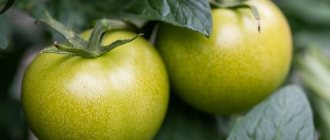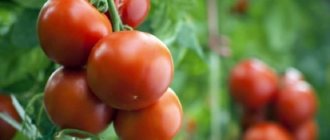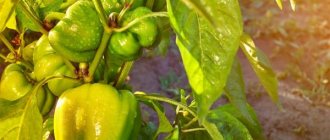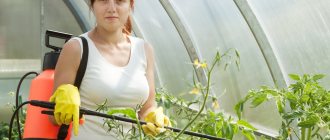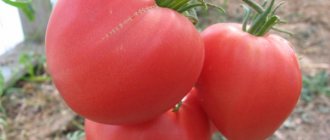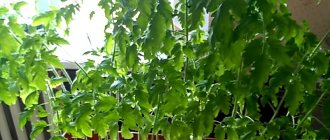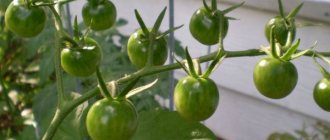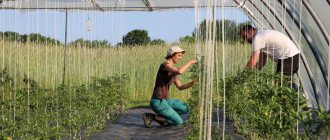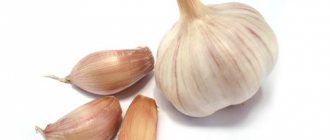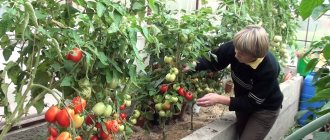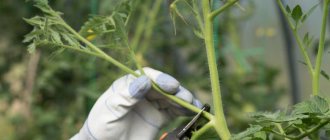Before deciding how to speed up the ripening of tomatoes in a greenhouse, you need to make sure that there are a lot of green fruits on the bushes. Indeed, in different areas, the ripening time may vary, taking into account the air temperature and conditions. Tomato varieties also play a role.
How to speed up the ripening of tomatoes in a greenhouse?
A very important condition that influences the acceleration of the ripening of tomatoes in a greenhouse is lighting. If plants do not have enough sun, this immediately affects their ripening. Therefore, the bunches should be exposed to the rays as much as possible; for this they are tied to poles. And the leaves that are located below are cut off, 2-3 per day.
- Remove pink or brown fruits so that they reach the house.
- Do not add fertilizer.
- Clean the leaves from rot with a saline solution: 1 cup of salt per 10 ml of water.
- Introduce 0.5 ml of ethyl alcohol into the fruits through punctures; this does not change their taste or composition of vitamins, but returns the red color.
- Prick the fruit halfway through with a toothpick.
- Place a red one among the green tomatoes; it is placed in a bag, which is put on a bunch of unripe ones.
Ripening time for tomatoes in a greenhouse
Choosing how to speed up the ripening of green tomatoes in a greenhouse requires taking into account several factors. Tomatoes ripen at different rates, depending on the variety, climate and daylight hours. After all, the fruit turns red thanks to a chemical called lycopene. And it is produced at the right temperature. It will not be produced if the summer is hot and the greenhouses are poorly ventilated. And when the nights become cooler, the production of the substance is activated. The ripening period for large-fruited tomatoes is 34 days after flowering.
Varieties recommended for greenhouses
To get a good harvest, you need to select tomato varieties for the greenhouse that are suitable for closed ground. In addition to the color, shape of the fruit and size of the plants, you should pay attention to the following features:
- Tomato ripening time;
- Taste, juiciness, sweetness of fruit pulp;
- What are the fruits for?
- Productivity of a hybrid or variety;
- Ability to self-pollinate;
- Will tomato varieties for a polycarbonate greenhouse be able to withstand temperature and humidity;
- Immunity to tomato diseases;
- Resistant to changes in humidity and temperature.
Classification of varieties
All varieties of tomatoes will be able to grow in the greenhouse, but taking into account the classification by growth, it will be possible to better manage the planting area of the greenhouse.
Tomatoes are divided into tall, medium-sized, indeterminate, that is, unlimited growth, large-fruited, raceme, cherry.
Tomatoes are also divided according to ripening time. There are super-early, early, mid-early, and late varieties.
What is better for a greenhouse: variety or hybrid?
When choosing between a variety and a hybrid, you need to take into account that, due to their unpretentiousness, varieties react less to deviations from the rules of agricultural technology and produce a harvest even with insufficient care. They should also be given preference if you plan to independently harvest seeds.
In turn, hybrids are characterized by the highest yield and quality indicators, but require careful care. In addition, the seeds of these tomatoes are absolutely not suitable for sowing.
It is worth choosing seed material taking into account your needs. Alternatively, representatives of both groups can be grown in a greenhouse.
High-yielding varieties
All gardeners are primarily interested in the most productive varieties of tomatoes.
These include the Miracle of the Earth variety, bred by a scientist from Novosibirsk. The variety is very hardy, so it can be grown in all regions of the country. The plant is tall, reaching a height of up to 2 meters.
Such tall varieties of tomatoes produce large, fleshy fruits. One fruit can weigh on average 400 grams, and some reach a weight of 1 kg. From 1 sq. meter you can harvest 15-19 kg of tomatoes.
The taste of the tomato is reminiscent of watermelon, so it is used to make juice, sauces, and is suitable for salads. It does not ripen immediately, so delicious fruits will be on your table until autumn.
Gardeners prefer to grow super-yielding varieties. These include “Mikado pink”. It is becoming the favorite among gardeners. The pink fleshy fruits are surprising, weighing up to 400-500 grams, but you can also get kilogram specimens. A productive variety can produce up to 8-10 kg from one bush.
Hurricane is an early ripening hybrid. From 1 sq. meter you can collect 11-14 kg of delicious fruits. Tomatoes are good because they can sit for a long time without spoiling. They can be transported over long distances.
Large-fruited tomato varieties
Small and medium-sized tomatoes are good for pickling, but you still want to grow large specimens at the dacha.
To grow large tomatoes, you should pay attention to the largest-fruited hybrids:
- Ural F1,
- Cavalcade F1,
- Krasnobay F1,
- Luxor F1,
- Cardinal F1,
- Elite F1,
- Russian size F1.
But the largest is considered the “Heavyweight of Siberia”. The bush is not tall, only 80 centimeters, but it ripens beautiful, elongated, rounded fruits of a rich crimson color. The average weight of one fruit is 400-500 g.
Cherry
Many vegetable growers are partial to small, juicy cherry tomatoes. Cherry tomato varieties for greenhouses delight with their diversity. You can choose cherry Dessert, which can grow up to 2 meters in height and stand strewn with red tomatoes for a long time. High-yielding variety, from 1 sq. meter you can collect up to 8 kg of sweet fruits.
Hybrid Madeira F1 bears fruit for a long time, the fruits are collected in clusters. Small tomatoes appear very early, 80 days after planting.
Fruitful early hybrids: Ira F1, Magic Harp F1 - with yellow fruits, are also in great demand among gardeners.
"Thumbelina" is loved for its productivity, resistance to diseases and the sweetish taste of its small fruits.
Liana
The vine varieties of tomatoes for the greenhouse are all tall. African pink vine and heart-shaped red vine are in great demand.
When the vegetables are ripe, the vine looks very beautiful, dotted with deep pink tomatoes. Weight up to 350 g, fleshy, almost without seeds and juice. The pulp is grainy. The taste is sweet, pleasant to eat fresh.
Dutch tomatoes
Dutch varieties of tomatoes are increasingly beginning to appear in the gardens of summer residents. Hybrids are valued for their resistance to diseases, self-pollination, and high productivity.
The selection of Dutch specialists is aimed at increasing shelf life and transportability, but the fruits are inferior to domestic hybrids in terms of taste quality. To achieve a pleasant taste, gardeners try to let them ripen on the bushes.
Tomatoes for greenhouses of Dutch selection:
- Ivanhoe,
- Afen,
- Belle,
- Benito,
- Big Beef,
- Debut,
- Diadem,
- Marfa,
- tomato with yellow fruits - Lemon boy.
Plum-shaped
High-yielding varieties of tomatoes in the form of plums are a must for every gardener. They are valued because they are suitable for pickling for the winter. Typically, plum tomato bushes grow up to 2 meters in height and are completely covered with tomatoes.
They ripen later than others, so they are used for canning separately or together with other vegetables. Gives tasty fruits
- Honey cream,
- Prunes,
- Angelica,
- Moskvich,
- Countryman,
- Picket.
There is yellow cream that will decorate any greenhouse:
- Ildi,
- golden lemon
- Monisto amber.
Yellow tomatoes are more delicate in taste, so they are most often eaten fresh.
Caring for tomatoes during fruit ripening
To ripen a tomato in a greenhouse, it is necessary to remove irregularly shaped fruits from the bushes, and direct those that grow low towards the sun, picking off the withered leaves. Pinching and pinching have a very good effect on the growth of tomatoes. Plants often branch, intertwine, and many shoots arise, where the bush’s strength goes.
Caring for tomatoes also includes the following methods to help ripen:
- Ventilation of the greenhouse.
- Cover the body with lime or lay down a white cloth.
- Make clamps on the stems, first cutting them 10 cm from the ground.
- Place plastic bags cut at the bottom on immature brushes; the temperature in the cap will be higher.
- Once a week, smoke the greenhouses with a tobacco smoke bomb. They help fight pests and also release carbon dioxide after combustion, which promotes photosynthesis.
Feeding tomatoes in a greenhouse during ripening
Greenhouse tomatoes are acutely lacking nutrients; they often need good feeding to ripen. And not only during the formation of the ovary, but during fruiting. Fertilizer for ripening tomatoes can be used at your discretion: iodine, ash, yeast, nitrophoska or superphosphate with sodium humate.
- On the ashes
. Dissolve 2 tablespoons of ash in 5 liters of boiling water, cool, dilute to 10 liters. Pour in a bottle of iodine and 10 g of boric acid, leave for a day. Dilute again 1 to 10, water at a rate of one liter per bush. - By leaps and bounds
. Dilute 100 g of yeast, 5 tbsp in 10 liters of water. spoons of sugar, 1 glass of wood ash, 0.5 liters of fermented chicken manure. Leave in a warm place for a day. Dilute again 1 to 10, water 1 liter per bush. Carry out the procedure no more than once a month.
Watering tomatoes during ripening in a greenhouse
Watering tomatoes during fruit ripening is also very important. At the same time, you need to monitor the humidity in the greenhouse; if there is too much of it, the plant gets sick, and the yield drops significantly. After each watering, the room must be ventilated. And water only with settled water and strictly at the root. The tomato variety also plays an important role.
In order for tomatoes to ripen quickly, watering must be correct:
- Low growing varieties
. When they ripen, they are given watering less often, and a month before harvesting they stop. - Tall varieties
. When ripe, they need to be watered once every 4 days; each bush requires up to 10 liters of water.
A product for accelerating the ripening of tomatoes in a greenhouse
Various preparations have been developed to accelerate the ripening of tomatoes. It is best to make special mixtures. The principle of operation is the same: they burn the foliage, and the roots devote their energy to feeding the fruits, not the leaves. You need to spray the bushes generously until the liquid begins to drain from the leaves. After 3 days, the leaves will fall off, and within a week the tomatoes will turn red.
The most popular solutions:
- Dilute 2 tbsp. spoons of superphosphate or nitrophoska with 1 teaspoon of sodium humate in 10 ml of water. The calculation is 5 liters per square.
- Dissolve 2 matchboxes of urea in 5 liters of water.
- Dilute 35 drops of iodine in 10 liters of water.
- Pour 2 tbsp into a bucket of warm water. spoons of superphosphate, leave for 2 days.
The best greenhouse varieties for different regions
The climate in different regions of our country is also different. Breeders have developed varieties and hybrids of tomatoes for greenhouses that can withstand the climate of your region.
For the Moscow region
Gardeners in the Moscow region often choose low-growing varieties of tomatoes for the greenhouse. Why are they better than tall specimens:
- Does not require removal of stepsons.
- They themselves stop growing above the designated height.
- They take up less space in the greenhouse.
- Easy to care for and harvest.
- They ripen earlier than others, because all the nutrients go to the growth of fruits, not stems.
- If tall specimens suddenly die, then short tomatoes can be planted in their place; they will have time to produce a harvest.
The ultra-early variety Riddle is very popular, which produces the first tomato 85 days after planting. Let's name other low-growing varieties: Alaska, Honey Cream, Aurora, Supermodel, Zolotoy Stream.
All these species grow well in greenhouses in the Middle Zone.
You can continue listing which varieties of tomatoes are suitable for the Moscow region and for greenhouses in the Middle Zone.
A good harvest is produced by hybrids and varieties: Vnuchenka, Askold, Borovichok F1, Fiery Heart F1, Summit.
It's time to stock up on reliable Belarusian varieties: Peremoga 165, Profitable, Kalinka-Malinka, Garant, Krokha, Izumrud.
For Siberia
In Siberian conditions, it is difficult to grow those varieties that are not adapted to temperature changes and cool summers. But breeders have developed excellent varieties that ripen in Siberia, in greenhouses.
Let's name the best varieties of tomatoes for Siberia, for example, Alsou. Even in Siberia, gardeners can get tomato fruits weighing 800 grams. The fruits of St. Andrew's surprise can grow even larger, up to 900 g. The King of the Giants grows even larger.
Pink varieties of tomatoes also grow well on Siberian soil. This is Sugar Bison, Abakan Pink, Heavyweight of Siberia.
For the Urals
The Siberian climate is somewhat similar to the Ural climate. Therefore, varieties for Siberia can be grown in the Urals. But for the short Ural summer, their own varieties have been bred: Alaska, Boni MM, Peach.
Large-fruited sweet varieties have also been bred for the Urals, which provide a generous harvest: Sweet Bull's Heart, Russian Size F1, Sibiryak F1, Pudovik.
Fleshy varieties for all regions - Great Warrior, Mazarin, Cardinal, Siberian Trump, Raspberry Giant, Novikov Giant.
Fleshy varieties not only amaze with their fleshy pulp, but also with their sweet taste.
For the Leningrad region
The Leningrad region is known for its humid climate and sharp cooling, so tomatoes for the Leningrad region must be those that can withstand high humidity and temperature fluctuations.
- The productive variety Rumyanetz St. Petersburg steadfastly endures all the surprises of the Leningrad climate.
- The low-growing variety Northerner can produce 4 kg of tomato from 1 bush. The rocket also pleases with a good harvest. The fruits resemble a rocket, tasty and juicy.
- The Baltic variety also does not let gardeners down.
- Siberian troika can grow even in an open garden bed and produce high yields.
There is a wide choice, so all gardeners will not be left without a harvest.
Tomatoes for the Kirov region
The Kirov region is distinguished by the fact that autumn comes early here. August is already cold and the nights are long. Therefore, gardeners are trying to grow tomatoes of the Kirov selection for greenhouses.
What is the difference? Adapted specifically for the climate of the Kirov region. The varieties do not disappoint summer residents, either in the taste of the fruit or in the yield.
Kirov "Agrosemtoms" breeds the most suitable, productive varieties. Among the early developments, hybrids became famous:
- Vyatich,
- Khlynovsky,
- Baron F1.
Varieties
- Stolypin,
- Moskvich.
3 months after the first sprouts emerge, the fruits can already be harvested.
To ensure that tomatoes are on the table all summer long, there are also mid-season tomatoes of the Kirov selection:
- Flamingo,
- Merchant,
- Viscount,
- Entertainer,
- Adonis, and
- Energy F1.
They produce the first harvest 3.5 months after germination.
Varieties for Udmurtia
Not all varieties of tomatoes are suitable for the Udmurt Republic, but only those that require a constant temperature regime.
The choice of tomatoes for Udmurtia is also not small. Their main feature is that they must be unpretentious. Let's name the best of them: Normandy, Novosibirsk pink, Titanic F1, Kostroma F1, Raspberry giant, Seven, Raspberry wine.
Sweet varieties have been bred for the climate of Udmurtia: Yuzhny Zagar, Djalo Santa, Russian Tasty, Grushovka and at least two dozen more hybrids and varieties.
Signs of maturity
The timing for harvesting ripe tomatoes varies greatly. Ripening depends on the variety of tomato, as well as the growing conditions. In our climatic conditions, it is advisable to plant early ripening varieties, the harvest of which is carried out as early as possible.
Pink tomatoes have colorless skin and red flesh when ripe.
It must be remembered that the manifestation of the external color of tomatoes in a greenhouse or open ground is based on the pigmentation of the tomato pulp and the skin of the fruit itself. Pink tomatoes have colorless skin and red flesh when ripe, while red tomatoes can be harvested when the yellow skin covers the already red flesh.
Other genotypes of tomatoes are also planted in the greenhouse, but most gardeners prefer when the harvest is represented by uniformly red-colored fruits. The process of carotenoid biosynthesis is characterized by a high level of sensitivity to temperature indicators. When the temperature exceeds twenty-five degrees, lycopene is inhibited and the first fruits can be picked completely red. For the biosynthesis of B-carotene, temperature is not so important and its presence can be observed even in green tomatoes.
In a polycarbonate greenhouse, you can easily get a harvest of red tomatoes, which is due to the optimal temperature conditions. Tomato ripening occurs as a result of changes in the ratio between lycopene and B-carotene, and correctly maintained temperature in a polycarbonate greenhouse allows this process to proceed as efficiently as possible.
In a polycarbonate greenhouse you can easily get a harvest of red tomatoes, which is due to the optimal temperature conditions
You can understand how much time it takes to ripen after assessing the characteristics of the variety and its adaptability to weather conditions in the growing region. Of course, you can also harvest green tomatoes, but it is more correct and practical to harvest the crop after it is fully ripe. To this end, you can speed up the ripening of fruits in several ways.
According to fruit characteristics
Of course, everyone prefers sweet, meaty tomatoes. Breeders have worked hard and developed varieties that are most often grown by gardeners.
The sweetest varieties
The sweetest varieties of tomatoes for greenhouses: Koenigsberg golden, Pink honey, Tsar Bell, Velmozha, Riddle, Honey drop, Raspberry giant, Roma, Orange pear.
There are sweet hybrids F1: Pink Spam, Pandarose, Bigorange Plus, Russian Happiness, Pink Berets, Large Pink, Raspberry Ring, Clear Falcon, Honey King, Tretyakovsky.
The most delicious and meaty varieties
Gardeners fell in love with Rosemary for its meatiness. Let's list other meaty varieties: Mammoth, Raspberry fleshy, Alsou, Ultra-ripe, Sevruga, Abakan pink, Golden Andromeda.
The best varieties of tomatoes for pickling
It turns out that not all tomatoes are suitable for pickling, but only those that hold their shape well, do not crack, and have a certain taste.
When choosing fruits for pickling, you need to pay attention to the following features:
- The size of the fruit should be small, even in shape, rich in color;
- The peel is dense, resistant to cracking;
- The walls are dense and fleshy;
- Low seed content;
- Friendly maturation;
- Tomatoes should be stored for at least a month.
The best types of tomatoes for canning: Koenigsberg, Red Banana, Tanya, Pickling Miracle, Pickling Delicacy, Summer Resident, Sakhalin, Rocket, Gina.
For juices and ketchups
To select tomatoes for juices and ketchups, it is necessary to select fleshy varieties: Minion of Fate, Bear's Paw, Volgogradsky, Novichok, Korneevsky Pink, Pink Flamingo - these types are used mainly for juices.
Such hybrids and varieties are suitable for sauce, ketchup and lecho.
- Big Beef F1 with sweet dense pulp.
- De-barao Tsarsky. Mid-late, universal.
- Brown sugar is late-ripening with a sweet taste.
- King of the early ones - excellent taste with a bright aroma.
- Mazarin. The fruits are red and have excellent taste.
- Mikado pink. The pink fruits are very tasty.
- Tolstoy F1. Universal. The fruits are bright red.
- President of F1. Early ripening. The fruits are red and sweet.
- Paul Robson. The fruits are reddish with a chocolate tint.
- Black Prince. The fruits are burgundy-purple, weight 500 g.
The best varieties of tomatoes for juice
Valery
Ukrainian farmer, author of the millionth YouTube channel “Garden and vegetable garden with your own hands.” Everything he films is based and verified on his personal experience.
The most delicious VARIETIES (not hybrids) of tomatoes, tested in practice, which we always gladly grow for salads and tomatoes.
For salads
To prepare salads, you can use any tomatoes, but you can choose the five best:
- "Bella Rosa F1" - for fresh salads.
- “Katya” is the best tomato for preparing salads for the winter.
- "De Barao yellow" - best for salads
- “Bull's heart” – used for making salads and juice.
- “Long Keeper” is stored for a long time, so you can prepare vitamin salads.
Ways to accelerate maturation
The ripening of tomato fruits in a polycarbonate greenhouse can be accelerated by quite affordable means. It is enough to correctly perform a few simple manipulations and you will be able to harvest ripe fruits without ripening green tomatoes at home. In order to speed up the ripening time, you need to perform the following steps.
- Spraying with certain means accelerates the ripening of fruits. For this purpose, you can use a special iodine solution, for the preparation of which forty drops of ordinary pharmaceutical iodine should be dissolved in a bucket of water. At this stage, fertilizing and irrigation should be suspended.
- Tomato harvesting can be done much earlier by turning the branches of low-growing plants towards the sun and then securing them with spacers and slingshots.
Disease-resistant tomato varieties
To get a good tomato harvest, you need not only to organize proper care for the crop, but also to buy the right planting material - disease-resistant hybrids.
Tomatoes that don't get sick
Let's name varieties and hybrids that, according to reviews from gardeners, suffer less from various tomato diseases.
- Vologda F1 Mid-season hybrid, produces 5 kg of fruit per bush.
- Ural F1 Mid-season. The fruits are large, red, one weight is 350 grams. Capable of producing 8 kg per bush.
- Firebird F1 Early ripening, determinate, carpal, 90 cm high.
- Bohemia F1. Determinate species. One bunch can produce 5 large tomatoes, and up to 6 kg of ripe, clean tomatoes can be harvested from 1 bush.
- Blitz Early ripening, determinate tomato, resistant to all diseases.
- Koenigsberg Indeterminate, high-yielding. From 1 sq. meters get up to 18 kg of harvest.
- Cio-chio-san. A mid-season variety that can produce a lot of tomatoes, weighing 40 g each.
- Apple tree of Russia. The variety is no problem. Produces red fruits weighing 100 grams 118 days after sowing the seed.
- Puzata hut. Large, sweet fruits weighing 350 g begin to ripen at 100 days.
- Banana legs. Small bushes, 60 cm high, begin to produce tomatoes weighing 100 g on the 80th day.
- Waterfall. An early ripe tomato, one brush of which contains up to 10 small fruits.
- Geisha. Will please you with the harvest on the 65th day. The fruits weigh 200 g.
- Ilyich F1. The hybrid does not get sick. Ripening period is 85 days. The fruits are filled up to 150 g.
- Crimson giant. Early variety. The bushes can bear fruits weighing 300 g and ripen in 100 days.
Despite the resistance of tomatoes to diseases, they also need to be monitored from the first days of planting.
Tomato varieties for greenhouses resistant to late blight
Breeders have developed hybrids and varieties that have time to ripen before late blight becomes rampant.
- Charisma F1. During the season, you can remove 7 kg of delicious tomatoes from a bush. Resistant to late blight and cladosporiosis.
- Gypsy Salad. Mid-season, determinant.
- Academician Sakharov. Juicy sweet fruits weigh up to 500 grams.
- Resonance. Early ripening. The bush grows up to 1.5 meters in height. Tomatoes weigh 300 g.
- Soyuz 8 F1. Ripening period is 100 days.
There are other resistant varieties:
Windrose, Snowdrop, Alaska, Snow Tale. Alpatieva 905, Little Prince, Budenovka, Tatyana, Cardinal, Cherny, Carlson, De Barao, Black Bunch F1. Black Pear, Lark. Karotinka, Tsar Peter, Dubrava, Orange Miracle, Perseus. What else? Grotto, Dubok, White filling, Lights of Moscow.
To prevent tomatoes in the greenhouse from getting sick, take preventive measures, because there is no 100% guarantee.
Resistant to cladosporiosis
This disease has another name - brown leaf spot. Light green or yellow-green spots appear on them, without sharp edges, and mold appears on the other side of the leaf.
The following tomatoes are not susceptible to this disease: Solnyshko, Russian Tasty, Mandarin, Seven, Beefsteak, hybrid Charisma F1, Coral Beads F1, Biathlon F1, Kostroma F1, Bohemia F1.
How to grow tomatoes in a polycarbonate greenhouse (video)
- The presence of large brown fruits on the branches inhibits the ripening of other tomatoes and it is advisable to harvest them at the stage of incomplete ripeness.
- The fruits ripen much faster if the tops of the plants are pinched. It should be taken into account that in order to ensure the growth of fruits, it would be correct to leave a couple of leaves above the inflorescences on which fruits have already set.
- The lower leaves must be removed up to the trusses, where the tomatoes are already ripening.
- Low and medium-growing bushes should have a maximum of four or five tassels, and the remaining tassels should be broken off properly. After such manipulations, the harvest is formed faster, which is due to the expenditure of plant energy on ripening the fruits.
- In a polycarbonate greenhouse, quite high efficiency is shown by limiting the flow of moisture from the roots. To ensure that nutrients do not go to the growth of green mass, at a height of ten centimeters in the stems, a through cut should be made with a knife, the length of which is about five centimeters. A wooden sliver needs to be inserted into the cut. To speed up the collection of ripe fruits, it is also possible to tighten the stem at a height of five centimeters with thin copper wire.
The presence of large brown fruits on the branches inhibits the ripening of other tomatoes
The effect of fertilizers on crop quality
Are you looking for a way to increase the shelf life and sweetness of fruits? Use fertilizers containing potassium and phosphorus , they have a good effect on the taste and product characteristics of the fruit:
- gives them sweetness and attractive appearance,
- increase shelf life.
But excess nitrogen in the soil will negatively affect the quality of tomatoes - their taste becomes watery and not brightly expressed.
Getting all the necessary nutrients at such an important stage as fruiting is simply necessary for tomatoes. Thanks to timely application of fertilizers, you can get a high yield of excellent quality.
Ripening time
How long it takes from germination to harvest and how long the plant grows depends on the tomato variety. In addition, ripening depends on how many ovaries the plant has formed, as well as on inherent “genetic factors,” environmental factors, and growing methods. The rate of ripening of greenhouse tomatoes varies greatly and depending on how much time is required for this process, all varieties of this vegetable crop can be combined into subgroups.
- Hybrid tomatoes. They are designated F1. They are characterized by a high ripening speed and produce the earliest possible harvest. The most popular hybrids, most of which grow well in a greenhouse, are represented by the varieties “Typhoon”, “Verlioka”, “Semko” and “Druzhok”.
- Greenhouse varieties. The collection of varietal tomatoes in the greenhouse occurs a little later. The earliest harvesting involves the use of early-ripening and ultra-early-ripening varieties. The most successful ones include “Hurricane”, “Yantarny”, “Samara”, “Junior” and “Joy of Summer”.
The earliest harvest of ripe fruits is typical for determinate varieties of tomatoes, while indeterminate varieties form ripe fruits a little later. Hybrid tomatoes ripen slightly earlier than varietal representatives. You can pick ripe fruits almost a month earlier.
Hybrid tomatoes are characterized by a high ripening speed and produce the earliest possible harvest
Assortment of greenhouse tomatoes
Many gardeners are confused by the abundance of tomato seeds for the greenhouse. The first thing you need to pay attention to is the region. Then to the release date. A good harvest can be obtained if packaging took place 2 years ago.
If you buy varietal seeds, you can take seeds from them. Hybrids also taste good, but seeds from them cannot be planted next year. They will not produce fruit of the same taste and quality.
Self-pollinating varieties
Self-pollinating tomatoes are best suited for greenhouses. It is difficult to list all self-pollinating types of tomatoes for greenhouses. This should be written on the packaging. If it is not written, ask the seller. If you haven’t found varieties that pollinate themselves, then open the doors and windows in the greenhouse or pollinate manually using a brush.
Standard tomatoes for greenhouses
Among the best universal standard varieties of tomato crops, we can name the following: Kameya, Buyan, Dubok, Yamal, Bushman, Boni MM, Denis, Red Pearl, Alpha, Florida, Little Red Riding Hood, Far North, Chelnok, Betta, Altaechka.
Varieties that do not require pinching
Almost all low-growing varieties of tomatoes, whose height is 45-50 cm, do not need to remove stepsons. Among them: Alsou, Fighter, Balcony Miracle, Top Ten, Hyperbole, Gina, Oak, Leningrad Chill, Snowstorm, Sanka, Skorospelka, Shuttle.
Carpal varieties of tomatoes for greenhouses
Many vegetable growers choose truss tomatoes for greenhouses because of their ability to quickly ripen in whole trusses.
In this group, the most productive species stands out - Maryina Roshcha F1 . You can collect 20 kg from one square. meters.
Early hybrid Samara F1, Gulliver, Strawberry tree, Zhigalo, Zhenaros F1. All of them are productive, tasty, and can be stored for a long time.
Original and exotic tomatoes
- Black Prince . A variety of Chinese breeders from the exotic group. The weight of one fruit is 500 g. Purpose – salad.
- The large striped boar attracts attention with the striped color of the tomato.
- Exotic Pink Siberian tiger resembles the coloring of little tiger cubs.
- The neon pink fruits of the Ozark Sunrise will immediately attract attention.
- Black Crimea will delight you with full-bodied black tomatoes weighing up to 500 grams.
- Rita black is good for its taste and chocolate color.
- Peaches and cream are yellow, sweet, beautiful tomatoes that will decorate any greenhouse.
Harvest time
Regular harvesting of fruits is very important for obtaining a high-quality harvest. Fruits must be picked at the stage of technological maturity of tomatoes, which is divided into the following stages:
- partial ripening of fruits;
- full ripeness of the fruit.
The fruits, pink when cut, are already quite suitable for eating. Selective harvesting at partial maturity can significantly increase the total yield. Tomatoes that are overripe on the bushes lose their taste and reduce overall yield. The saturated green fruits can be left on tomato bushes until the first days of September.
The earliest harvesting of greenhouse tomatoes involves the use of early-ripening and ultra-early-ripening varieties
When to feed?
To fertilize tomatoes, you need to choose a certain time of day and weather conditions.
- For open ground tomatoes, all spraying can be carried out in the morning or evening, and in cloudy weather - at any time. The main thing is that the treated bushes should not be exposed to sunlight, otherwise burns cannot be avoided.
- Spraying carried out in the evening hours is considered more effective, since all components of the solution are better absorbed into the plant and do not evaporate during the day.
- Root feeding of greenhouse tomatoes is carried out in the morning, followed by ventilation.
Harvesting tomatoes in a greenhouse (video)
The collected fruits must be stored after ripening. It is this process that allows you to preserve tomatoes for as long as possible, and the gardener will be able to boast of having independently grown, juicy home-grown tomatoes on the New Year’s table.
In order not to lose the material, be sure to save it to your social network VKontakte, Odnoklassniki, Facebook by simply clicking on the button below:
Growing tomatoes in greenhouses has significant advantages over growing them in open ground. The greenhouse is most useful for gardeners in the northern regions of Russia, who do not have the opportunity to keep fruits until they are fully ripe on unprotected soil. The greenhouse allows vegetables to complete their development unhindered, despite unfavorable weather. Since each variety has its own ripening time, it is impossible to definitively answer the question of when to harvest tomatoes in a greenhouse. However, you can, based on external signs, determine the degree of readiness of the fruit with your own hands.
Rating of varieties by bush height
According to the height of the bush, tomatoes for the greenhouse are low-growing, determinate, semi-determinant
Determinate tomatoes
Determinate bushes are standard bushes that do not require staking or pinching. They stop growing as soon as ovaries appear at the end of the shoot.
- To choose the best determinate varieties of tomatoes for the greenhouse, you need to get acquainted with their description. Alpha becomes the leader . It grows to only 55 cm in height. The thick stem holds red, strong tomatoes well, weighing 56 grams. The fruits are good in salads, and juices are made from them.
- The varieties of low-growing tomatoes are continued by the vegetable crop Valentina . Ripening period is 102-105 days. Oval tomatoes hang in clusters on stems, their weight is 90 g. The pulp is tasty, fleshy, and can be stored for a long time without cracking.
- Among the popular hybrids is the early hybrid Explosion F1 . After sowing the seeds, only 100 days will pass and delicious red tomatoes will appear on your table. A high-yielding hybrid: 3 kg of fruits are collected from each bush, and the bush grows only up to 45 cm. It is unpretentious. Receives only positive reviews.
- Hybrid Azhur F1 – medium height. A standard bush 60-90 cm in height holds a mass of slightly flattened red tomatoes, weighing 240-280 g. It is distinguished by high productivity and tolerates both temporary drought and extreme heat. With good care from 1 sq. meter you can remove 12 kg of tomatoes. Tomatoes, even in a greenhouse, are not affected by any of the most common tomato diseases.
- Alaska variety ripens very quickly in the greenhouse . The height of the bushes is no more than 50 cm, super early tomatoes ripen in 80-100 days. Taste qualities are the highest. Despite the low growth, more than 2 kg of tomatoes are harvested from one bush. Resistant to diseases. Easy to care for.
- The mid-season hybrid Bourgeois is also popular among gardeners. From the moment of planting until the appearance of the first red tomato, 100-110 days pass. The plant is standard, up to 1 m high. The pulp is dense, fleshy, sweet. Not afraid of diseases and pests.
- Determinate tall hybrid: Blagovest F1 , characterized by rapid ripening of fruits. Each tomato weighs 120 g, often reaching 150 g.
Semi-determinant
Semi-determinate are tall tomatoes for the greenhouse that ripen late. They have a powerful root system, so they hold a high yield well.
When buying tomato seeds for a greenhouse, pay attention to semi-derminant hybrids and varieties. They have a number of advantages compared to determinant (short) and indeterminate (with unlimited growth):
- Early ripening ones ripen two weeks earlier compared to indents.
- Resistant to most tomato diseases.
- The marketable appearance of tomatoes is preserved for a long time.
- The average height of the bushes makes it possible to grow them in low greenhouses.
- The distance between the trusses is only 12-16 cm, and for indeterminate tomatoes it is 25-30 cm, so they have time to form many ovaries.
- Very fast setting of tomatoes.
- You can form 2-3-4 trunks, increasing the yield of each bush by 2-3-4 times.
- Famous varieties of tomatoes for greenhouses from Dutch companies are: Qualityte, Gravitet, Devanet, Caponet, Gandola F1 and President F1.
- Russian companies also have early hybrids for greenhouses: Flamingo F1, Energo F1, Semko 99 F1, Salar F1, Aksinya F1, Isfara F1.
- Tomato varieties: Agafya. Alphonse, Anyuta, Andromeda, Belfort, Velikosvetsky, Verochka and others also receive only positive reviews from gardeners.
Many vegetable growers have learned to grow tomatoes with 4 stems and reap a very large harvest. To get a great harvest, half-dents need to be well fed and watered on time so that they can hold such a mass of fruit.
Indeterminate varieties of tomatoes for greenhouses
Indeterminate tomatoes are tall vegetable crops. They can stretch up to 2 meters or more until their growth is stopped.
Let's look at the best varieties of indeterminate tomatoes for the greenhouse.
- The leader among varieties is Octopus . It can grow up to 5 meters. Tomatoes grow up to 150 grams, but they are very sweet, juicy, and tasty. There is no need to shoot, because fruits can grow on all shoots. Gardeners grow it because of its record yields and resistance to all diseases and pests. Collected tomatoes can lie for a long time, maintaining their appearance. They are canned and used for making sauces, juices, and salads.
- Pink Tsar - a mid-season tomato crop reaches a height of 150 cm. Tomatoes of a soft pink hue reach a decent weight - 350 grams. They have dense, sweetish flesh. A high-yielding variety, one bush produces up to 7 kg. Diseases avoid him and does not require much care. But young seedlings must be protected from the Colorado potato beetle.
- A powerful hybrid, Star Gold , produces early-ripening cherry tomatoes that ripen in bunches. The tomatoes are small, fragrant, bright yellow in color.
- An ox heart in a greenhouse grows up to 2 meters. Ripe late. After planting, you will have to wait 115 days for the harvest. If we take the best varieties of pink tomatoes for the greenhouse, then this is Ox's Heart. The fruits are tasty, sweetish, very fleshy. They are attracted by their beautiful pink color. The shape is round, slightly elongated downwards, which is why it gets its name. It is resistant to tomato diseases. Despite the large fruits, they rarely crack.
Ripening time
As already mentioned, there is no exact date that you should focus on when picking tomatoes. The following factors influence the ripening time of tomatoes:
- Location of the site. Since there are areas on the territory of Russia whose climatic characteristics differ significantly from each other, it makes no sense to give uniform recommendations. If a southerner can afford to harvest at the beginning of August, then a northerner by this month will collect completely green, unfit for consumption fruits;
If we talk about the exact ripening time, then for different varieties it can vary from 80 to 120 days. We will talk about some varieties of tomatoes and their characteristics in the next section.
Collection of different varieties of tomatoes
Despite the fact that it is not possible to cover all the variety of tomato varieties, we will consider the most popular options and the time it takes for them to ripen.
Table 1. Tomato varieties and timing of their ripening
| Variety | Maturation | Description |
How to feed?
To ensure that fertilizing does not harm fruit-bearing tomatoes, it is important to know the technology and timing of its implementation. You can apply useful substances at the roots of plants, or you can spray the trunk, leaves and fruits with a spray bottle.
Root method
Root feeding of tomatoes during fruiting is carried out in liquid form - the active ingredients are pre-diluted in water in the recommended proportions.
Applying fertilizer at the root is always accompanied by watering the tomatoes - first you need to water them with plain water, and then with a nutrient solution. This is done so that agrochemicals do not damage the root system.
Moreover, abundant watering is recommended for open ground, and moderate watering for greenhouse tomatoes.
Important! During fruiting, it is not advisable to water tomatoes with urea solution; it is better to use it to spray the green parts of the bush.
Foliar method
The components of formulations for spraying tomatoes are absorbed much faster than when watering at the root, so foliar feeding has become widespread.
The main disadvantage of this type of fertilization is the increase in humidity and evaporation in greenhouse conditions. In addition, tomatoes do not like leaf irrigation.
In general, the instructions for spraying are quite simple: the nutrient solution is prepared following the recommended dosages, filtered if necessary and poured into the sprayer. In most cases, the working solution must be applied liberally over the entire surface of the bush.
Features of tomato harvesting
Greenhouse heating plays a significant role in harvesting. If the gardener has the ability to control the temperature in a given room, then there are no obstacles to the year-round harvesting of ripening fruits.
If your greenhouse is not equipped with heating and depends on the weather outside, then you should focus on the following tips:
- Harvesting begins when the night temperature in the greenhouse approaches zero, and the daytime temperature does not rise above eight degrees;
- If you plan to sell tomatoes, you can pick them green on the branch so that they ripen at the same time as each other and are better stored;
Video - Details of tomato harvesting in a greenhouse
Pest control on tomatoes
If agricultural practices are not followed when growing nightshades in a greenhouse, or if there is no proper care for the beds, wireworms attack. Helps to cope with parasites:
- construction of traps;
- adding mineral complexes;
- liming of soil;
- insecticide treatment.
Insecticides
- chemicals intended to kill harmful insects.
Fungicides
(from Latin fungus “mushroom” + Latin caedo “kill”) - chemicals for combating fungal plant diseases
To destroy a mole cricket that gets into a greenhouse with contaminated soil, a product is poured into the tunnels dug by pests, which is prepared by dissolving 3 and 4 tablespoons of vinegar and 150 ml of hot pepper tincture in 10 liters of water. If the method is ineffective, insecticides Grizzly and Medvetox are used.
Whitefly. a moth-like butterfly that breeds indoors in the absence of proper care for tomatoes, leaves waste products on the leaves and shoots in which sooty fungi multiply and provoke the death of plants. To destroy whiteflies, the insecticide Citkor, which is produced on the basis of cypermethrin, is dissolved in 10 liters of water and sprayed on the branches; re-treatment is carried out after 3 weeks.
View this post on Instagram
Publication from Andrey Zimarin. GARDEN AND COTTAGE (@shkola_ogorodnika)
To prevent spider mites from drinking juice from leaves, before growing tomatoes, the remaining roots are removed from the greenhouse, the soil is dug deep, and weeds are pulled out. When a pest appears, the tops and leaves are sprayed with an infusion of onion peels, Fitoverm.
If the care requirements are not met, a cutworm will appear, gnawing the stems and leaf petioles. To combat the pest, a decoction of wormwood is prepared, and the tomatoes are treated with Strela biofungicide.
Sometimes root-knot nematode larvae are brought into the greenhouse along with the soil. When a parasite is detected, a tablet of the drug Glyocladin is placed in the holes in which the bushes are planted. Twice a month the plants are watered with liquid Ecogol. If the insect spreads strongly, which happens when pest prevention is ignored when caring for a crop, treatment with Basamil is performed.
Degrees of ripening of tomatoes
Each tomato goes through several stages during its development period, which will tell the gardener the condition of the fruit better than any approximate dates. Tomatoes are distinguished by the fact that they can be used for cooking in almost any condition, but each such condition requires its own approach.
Unripe tomato gaining weight
Unripe tomatoes are easily recognized - their dimensions are significantly smaller than the standard for a particular variety. The color of such fruits is usually dark green, they are elastic and hard to the touch. It is recommended to leave unripe tomatoes on the bush until their skin begins to gradually lighten. The use of such tomatoes is simply unprofitable, due to the fact that they have not yet reached their full size.
Tomato that has reached milky ripeness
The appearance of the milky-ripe fruit does not inspire doubt - the whitish tint of the skin indicates that the berry is clearly not ready for use. However, if you cut the fruit, you will see a pink center, which is an indicator of the onset of milk ripeness. This stage is ideal for moving the fruits to the cellar for ripening. As a rule, tomatoes of this condition require about two and a half weeks to ripen.
Tomato that has reached blanzhesky ripeness
The condition of blanzhe ripeness involves coloring the tomato in a rich orange-brown hue. This tomato is hard to the touch, elastic and has almost reached the optimal dimensions for its variety. Fruits that have reached blanzhesky ripeness should be moved to the cellar. However, unlike milky ripeness, blanzhevoy requires less time for ripening. One week is enough for the fetus to reach maturity.
Ripe tomato
The final color of tomatoes depends on their type. In addition to red, there are pink, yellow and even purple varieties. A universal sign is the characteristic shine of the fruit peel. The life of ripe tomatoes is short. They are used for cooking raw or canned as quickly as possible to avoid massive rotting of the berries.
Ripening tomatoes
Ripening is an integral part of storing tomatoes for many gardeners, as it allows them to extend their shelf life to two and a half months. For comfortable ripening, tomatoes will need the following conditions:
- The most important nuance in extending the ripening period is adjusting the temperature in storage. It should not rise above ten to twelve degrees for green-ripe specimens. Ripe tomatoes will need zero temperatures to maintain their quality. It should be remembered that some tomatoes can be susceptible to rotting even at low temperatures;
Important! Before ripening, it is necessary to carefully examine and sort all the tomatoes. Only those fruits that have no signs of mechanical damage, diseases or cracks are allowed for both short-term and long-term storage. During storage, the stalk should be separated only if it comes off easily.
Late blight
Unfortunately, when growing tomatoes, gardeners often encounter such an unpleasant phenomenon as late blight. It also happens that the disease manifests itself only during storage. Late blight refers to fungal spores that annually infect many bushes with fruits. First, the fungus invades the leaves, which gradually dry out and turn brown. If these primary symptoms are ignored, the disease spreads to the berries, rendering them unusable.
Treatment and prevention
Despite the fact that this disease cannot be treated, it can be contained using the following measures:
- Garlic spray. Mushrooms quickly die under the influence of garlic, so this method works flawlessly. In order to make such a composition, you need to mix one and a half glasses of crushed heads of garlic, a couple of grams of potassium permanganate and ten liters of water. The resulting composition is first distributed before the formation of the ovary, the second - ten days later. Further preventive spraying is carried out every two weeks;
